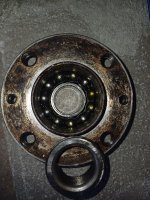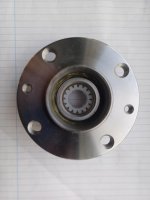I'm afraid that "ever was it thus". Folk who get very dirty at their work have always been looked down on by the majority, not all though, of besuited clerical types. OOPS, now just watch the offended posts roll in!
The workshop at that garage was very old and draughty. It consisted of many rather corridor type work areas because of the many pillars which held the roof up. Workshop doors was never closed except after finish time because they really did nothing to stop the cold air blowing through. Our rest area was in a wee dead end bit of the shop where we had an old sofa and several car seats all arranged around the volcano. The volcano was a waste oil burner which used the waste engine oil and dirty paraffin from the parts washer. It had a large round base about twice the diameter of one of the old metal dustbins but was only a couple of feet tall. on top of this was a lid with a smaller hole of maybe a foot? in diameter into which fitted the "volcano" flue. This flue looked a bit like the funnel on an old type American train. Narrower at the base where it fitted into the oil reservoir and tapering out until, right at the top, which was a little above eye level when standing, it reduced again. all up the sides of the flue were air vents which encouraged it to draw in extra air when hot.
At the start of the day, with the funnel removed, the base would be filled to about half way with waste oil and paraffin - and whatever else had been serreptitiously tipped into the waste oil, like brake fluid etc. Then a lit rag would be dropped in through the hole and the funnel placed back on top. For a while there wouldn't be much to see, maybe just a flicker of flame from the rag glimpsed through the flutes on the funnel. Then, as it started to heat up, a noxious white smoke would come out of the funnel as the waste oil etc started to vapourise. As it continued to heat the vapour in the funnel stack would ignite and the whole thing really "took off" The stack would glow red hot and it made a noise like a ram jet (think V1 flying bomb rocket motor but a good bit quieter). There's no way it would have been allowed now a days! It produced a ferocious amount of very localized heat - our wee corner was really nice and cosy, but it's effects were not felt at all in the greater workshop area. Near it though? well! For example, on one occasion the apprentice, who did a lot of the degreasing and engine cleaning using a compressed air paraffin gun - so the vapour got engrained into his overalls - was standing with his back close to the stack to get a warm up before going back into the cold workshop. I remember seeing the steam, or what I took to be steam, rising from his overalls but thought nothing of it as I thought it was just because his overalls were wet. Suddenly the foreman jumped up, shouting at the poor chap to get away from the fire and roughly grabbed him and pulled him away. One of the older men shouted at him to leave the lad alone, thinking, I suppose, that he was just being rough with him for fun. However the foreman then explained that what we were seeing was not steam but paraffin vapour and it might have ignited at any moment turning the poor apprentice into a human torch in the process. Amazingly nothing was done about getting rid of the volcano and we were just advised to keep a good eye on each other when near it and no horse play near it either. Health and safety would have had a field day! Must say though, on a cold snowy winters day, or when you'd been out on a breakdown, that volcano was your best friend. I've only ever seen one other like it and that was in a scrappy's bothy - it was only about half the size of ours though.



